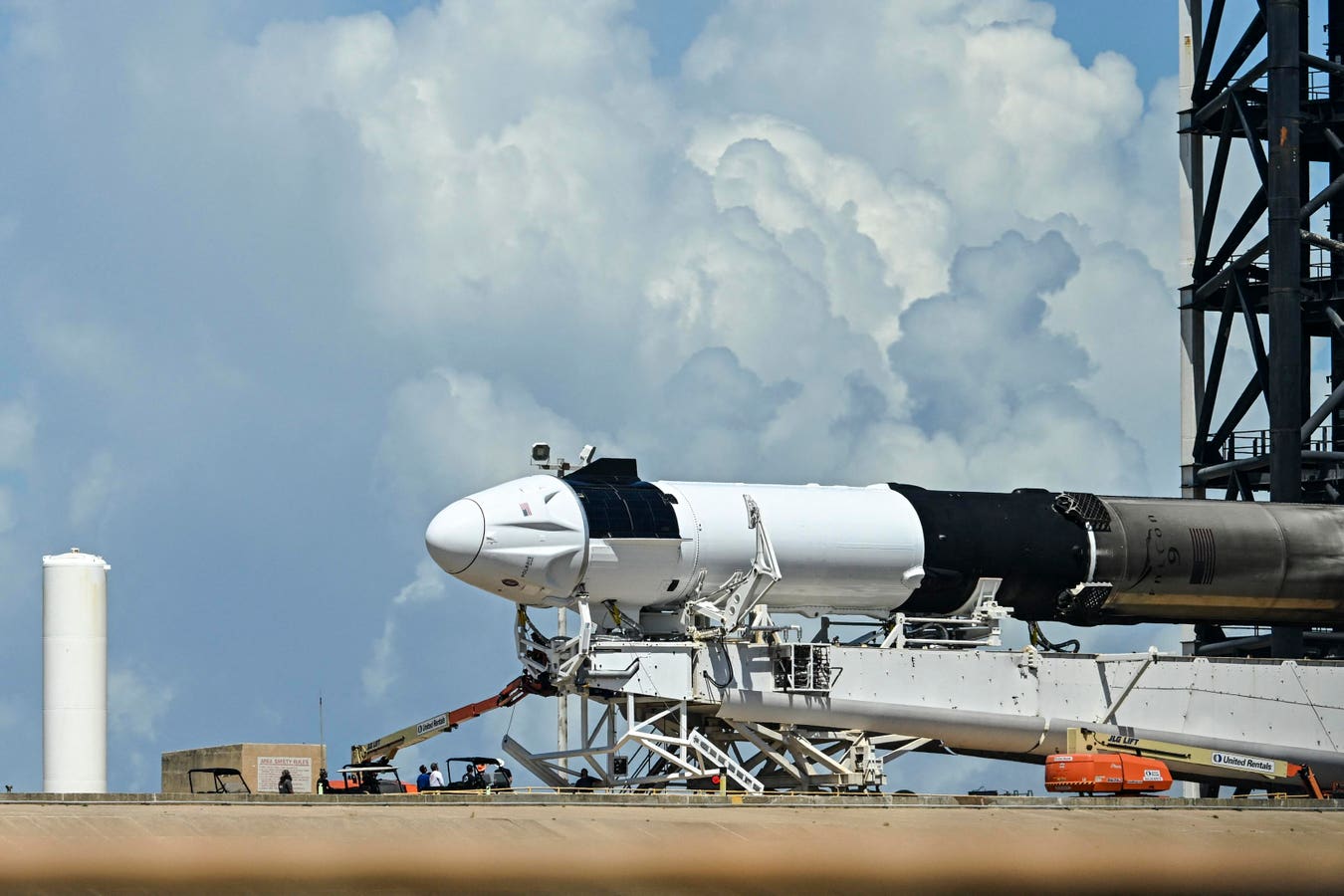The four independent astronauts now circling the planet – in a demo flight headed by billionaire-pilot Jared Isaacman – are testing out leading-edge aerospace technologies that will be pivotal to SpaceX’s stepped-up quest to land human explorers on Mars.
SpaceX leaders, the commander of the Polaris Dawn mission and space scholars all agree the speedily evolving spacesuit technology and laser communications prototypes unveiled during this orbital sojourn are being perfected in the race to loft the first futuristic Mars-bound Starships.
“We hope the results from our mission will accelerate SpaceX’s vision to make life multi-planetary,” Isaacman said during a press conference at the Kennedy Space Center in Cape Canaveral, on the eve of his launch aboard a SpaceX Dragon capsule. “Throughout our mission, we will aim to inspire humankind to look up and imagine what we can achieve here on Earth and in the worlds beyond our own.”
The next-generation SpaceX spacesuits debuted by the Polaris orbital team feature a 3D-printed helmet, complete with a cutting-edge heads-up display and camera, that echoes the spacey robot headgear modelled by the French band Daft Punk.
“While Polaris Dawn will be the first time the SpaceX EVA suit is used in low-Earth orbit, the suit’s ultimate destiny lies much farther from our home planet,” SpaceX’s leaders say. “Building a base on the Moon and a city on Mars will require the development of a scalable design for the millions of spacesuits” needed for humans to spread out across these celestial outposts.
These space travellers and their spacecraft will be connected up with Mission Control and the cybersphere via SpaceX’s Starlink satellite constellation, enhanced via super-speed laser links.
This inter-world web technology will be vital to the astronaut landings on Mars that Elon Musk envisions ahead, Kip Hodges, one of the top space scholars in the U.S. and the founding director of the School of Earth and Space Exploration at Arizona State University, told me in an interview.
Elon Musk, SpaceX founder and chief designer of the colossal Starship capsule, told his 196 million followers on X over the weekend: “The first Starships to Mars will launch in 2 years when the next Earth-Mars transfer window opens.”
“These will be uncrewed to test the reliability of landing intact on Mars,” Musk said. “If those landings go well, then the first crewed flights to Mars will be in 4 years. Flight rate will grow exponentially from there, with the goal of building a self-sustaining city in about 20 years.”
Creating a dual-planet civilization, he predicted, will secure humanity’s collective longevity into the far future.
The Mars-bound Starship is emerging as a “technological marvel,” Professor Hodges says, and augurs a revolution in spaceflight that could reverberate across two planets, and then beyond.
The Starship capsule, with its capacity to transport 100 spacefarers and its 1100 cubic meters of pressurized space, could deploy a ring of Starlink satellites when it reaches Mars orbit, Professor Hodges states in a paper he co-authored with Paul Wooster, SpaceX Principal Mars Development Engineer, and a constellation of other vanguard space scholars.
A first wave of uncrewed Starships, they say, “could “enable delivery of mobile robotic assets that could be used to conduct planetary science research either autonomously or through high-latency teleoperation.”
These remotely piloted precursor missions, before the first astronauts lift off, “will also carry hardware needed to support the human base including equipment for increased power production, water extraction, LOX/methane [rocket fuel] production, pre-prepared landing pads … [and] exterior shelters for humans.”
“An ultimate objective of SpaceX is to develop self-sustaining cities on Mars,” they add, “and current SpaceX architecture plans call for multiple Starship flights to be launched to Mars at every launch opportunity.”
During a fantastical overview of his masterplan to create the first cosmopolis amid the orange-red sandhills of Mars, while warming the planet and restoring its atmosphere and oceans, Musk said he aims to surround this second foundation for human civilization with bands of Starlink satellites to beam internet coverage down to these first-generation Martians, which will enable them to YouTube their adventures to fans across the twin planets.
“Starship is the first design of a rocket that is actually capable of making life multi-planetary,” Musk said as he sketched out a two-decade timeline for flying one million inter-world migrants to the Red Planet as it is terraformed.
That will require 10,000 flights of Starship, he says, with fleets set to leave Earth orbit every 26 months, as the Hohmann transfer window opens for optimum flights to the reddish orb, which revolves along the outer boundary of the solar system’s habitable zone. The 2028 window that Musk pinpointed for lofting the first humans to Mars would land them in the late summer of 2029, according to NASA scientists who charted these Hohmann flights for the next two decades.
During his Starbase talk, Musk said he aims to “build out as quickly as possible a self-sustaining civilization on Mars,” and added that SpaceX – the world’s first independent space superpower – would build several thousand Starships each year to reach that goal.
The live-streamed departure of these Starship flotillas every other year would likely be watched by billions of entranced citizens: “It would look like Battlestar Galactica,” Musk mused, as waves of discoverers begin setting off for the New World on Mars.
Professor Hodges says that if rovers equipped with sophisticated cameras and laser scanners are deployed by the first unmanned Starships slated to land in August of 2027, these robot-photographers could beam back their imagery of the landing site to aid in the training of the human spacefarers who will follow.
His Digital Discovery Initiative team of scientists and virtual reality modelers at ASU could rapidly transform these photographs and point clouds into photorealistic VR simulations of the site, he says, that can be explored in intricate detail by the astronauts slated to touch down in the later landings, and by mission planners across SpaceX.
“While Elon Musk’s intention to send the first Starship landers to Mars in only two years is bold, doing so would provide an extraordinary opportunity to demonstrate how immersive virtual experiences on the Martian surface could pave the way” for the astronauts who will join their robotic forerunners, Professor Hodges told me.
“As the time for crewed missions draws nearer, these same virtual replicas [of the landing site] could be used to plan surface activities during those missions and train the crew,” he says.
SpaceX “could then design, build, and study cities in virtual reality prior to actually creating these built environments.”
“All of this is possible in the timeframe envisioned by Musk using currently available or rapidly developing technologies, many of which are already part of the SpaceX ecosystem,” Professor Hodges predicts.
“All that is needed is the vision to realize their promise.”
He adds his DDI team has already begun constructing virtual simulations of the Jezero Crater site now being mapped and photographed by NASA’s Perseverance Rover, and that his group could add an expanding sequence of robotically surveyed sites to its Virtual Mars project – available to mission controllers across SpaceX.
Meanwhile, Jared Isaacman, a top-notch pilot with a degree from Embry‑Riddle Aeronautical University who collects and flies fighter jets, aced a high-risk but super-photogenic spacewalk – hundreds of kilometers above the International Space Station – with his black silhouette backdropped by a glowing blue Earth in a live stream from SpaceX.
Not just an iconic space aviator, Isaacman is also an incredible philanthropist, who during an earlier orbital expedition donated $125 million to the St. Jude Children’s Research Hospital. He has also offered to fund and pilot another SpaceX Dragon flight to rescue the Hubble Space Telescope, which is in danger of falling back to Earth, by boosting the observatory into a higher orbit.
Isaacman says he intends to commission the very first Starship, which is now counting down to its fifth test flight, when it is cleared to carry astronauts.
So far the billionaire-aeronaut hasn’t revealed whether he might opt to join the first wave of Starships headed to Mars in 2028, but that new timeline was only unveiled on the eve of his launch into low Earth orbit.
Elon Musk, during his oracle-like prophecies on Starship’s future at the Starbase launch center, suggested Mars would only be a stepping stone toward an increasingly expansive quest for humanity to explore and move ever-outward.
“Starship would ultimately be capable of of reaching anywhere in the solar system,” SpaceX’s creator declared. “We want to be a multi-planet civilization, and ultimately be a multi-stellar civilization.”
Read the full article here





